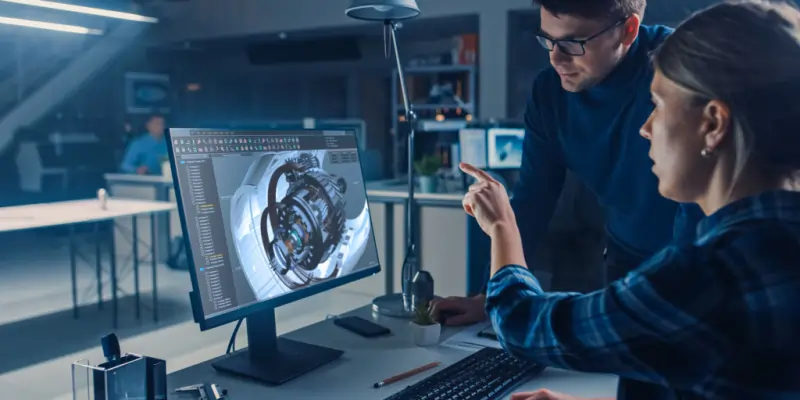CAD vs CAE: Choosing Your Career Path in Design and Analysis
If you're considering a career in engineering or a related field, you've likely encountered the terms CAD and CAE. But what do these acronyms really mean, and how do they differ? In this beginner-friendly guide, we'll demystify CAD and CAE, helping you make an informed decision about your career path in the exciting world of design and analysis.
2023-09-26

What is CAD (Computer-Aided Design)?
Imagine you're tasked with creating a new product—a car, for instance. CAD is the software and methodology that allows engineers and designers to create detailed digital models of this car. These models are not just pretty pictures; they are rich with data, containing precise measurements, material properties, and geometric information.
Why CAD Matters:
- Designing the Blueprint: CAD helps engineers create the blueprint for a product. It's like sketching a design, but in a digital, highly accurate form.
- Visualization: CAD models allow you to see your product from every angle, zoom in to inspect details, and even simulate its operation.
- Collaboration: CAD facilitates collaboration among design teams, ensuring everyone is on the same page when it comes to the product's design.
Who Should Consider CAD?
If you enjoy the creative process of designing, sketching, and turning ideas into detailed plans, CAD might be your calling. CAD professionals often work on product design, architecture, and various engineering projects.

What is CAE (Computer-Aided Engineering)?
Now, let's say you've designed that car using CAD. CAE comes into play when you want to test how your car performs in different conditions. CAE uses simulations and analysis tools to predict how a product behaves under various stresses, like heat, pressure, or structural forces.
Why CAE Matters:
- Virtual Testing Ground: CAE allows engineers to subject their designs to virtual tests, saving time and resources compared to physical testing.
- Optimization: It helps optimize designs by identifying weaknesses or areas for improvement, leading to more robust and efficient products.
- Safety and Reliability: CAE ensures that products are safe and reliable under real-world conditions, reducing the risk of failures.?
Who Should Consider CAE?
If you're fascinated by understanding how things work, predicting their behavior, and optimizing designs for performance and safety, CAE might be your path. CAE experts are in demand across industries like automotive, aerospace, and structural engineering.

Choosing Your Career Path: CAD or CAE?
To decide between CAD and CAE, consider your interests and career aspirations. If you enjoy creating detailed designs and are drawn to the creative side of engineering, CAD might be the way to go. On the other hand, if you're passionate about analyzing and improving designs to ensure they meet high standards of safety and performance, CAE could be your calling.
It's also worth noting that some professionals work at the intersection of CAD and CAE, using both to bring designs from concept to reality. Ultimately, the choice is yours, and there's no one-size-fits-all answer. The important thing is to follow your interests and passion as you navigate the dynamic field of design and analysis in engineering.
Author

Ganesh Verma ( Design Engineer)
Total 7 Blogs viewDesign Engineer in BIW domain and working in Mahindra world city, Chennai.
Author’s journey so far:
Back in my mechanical engineering days, I used to believe that getting a job as a mechanical engineer would be a walk in the park. After all, it's a field that's always in demand, right? But reality hit hard when I started hunting for jobs in mechanical engineering.I found a few gigs, but they didn't pay much, and the work atmosphere was far from pleasant. I even tried looking for jobs near my village, around the MIDC area, but it didn't seem like a promising career path.Then, I stumbled upon the idea that design engineering, especially in the automotive sector, could be the way to go. I scoured the internet for ways to learn how to design automotive parts. That's when a friend of mine, who was already working in design, told me about Isopara.Without wasting much time, I made up my mind, said goodbye to my village, and moved to Pune, close to the Isopara office. I attended classes every day, giving it my all. But, despite my efforts, cracking interviews seemed impossible, partly due to personal issues.That's when I decided to have a heart-to-heart with Prashant, one of the instructors at Isopara. We sorted out the problems I was facing during interviews. Soon enough, I received three interview calls and aced them all, landing job offers.This success story owes a lot to Isopara and Prashant, who guided and supported me through every step of my learning journey.
Course done and recommended by Author:

Other Trending Videos
- 3-Steps || Choose the Right CAD Software with the Right Domain
- Roadmap || Become an Automotive Design Engineer in BIW Domain.
- Roadmap || Become an Automotive Design Engineer in Plastic Domain
- Not Getting Interview CALLS? || Career Guidance
- Mechanical Design Jobs || Domain Skill
- Why CAD and its Importance? || By Experts
- Difference || CAD Engineer Vs Design Engineer
- Best CAD Software to Learn & Build a Career || By Experts
- Best CAD Software to Learn || Most Demanded by Industries
- How to Become a Design Engineer? || By Expert.



